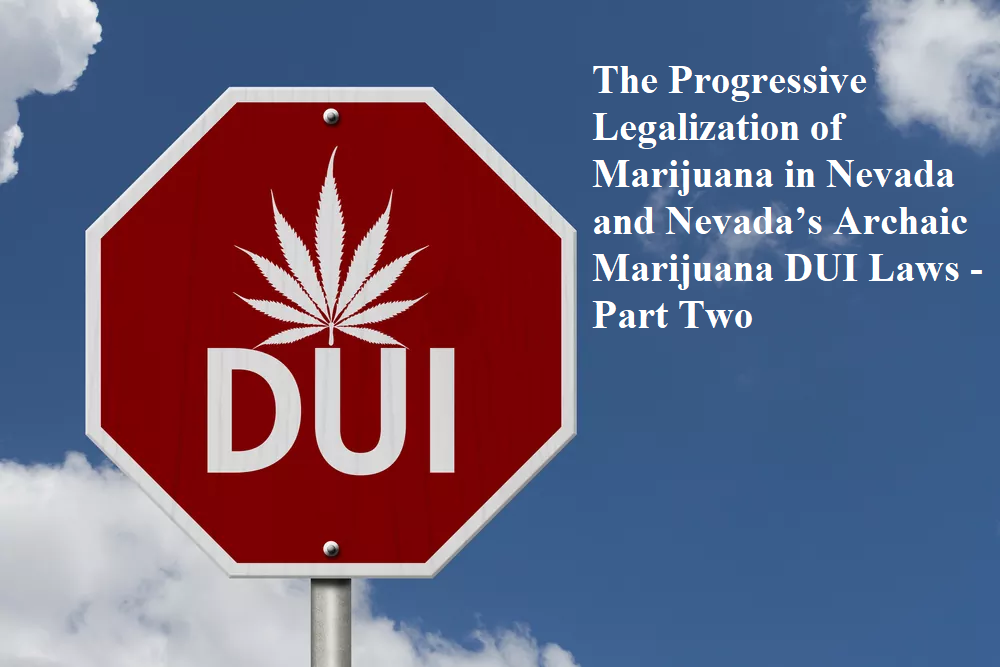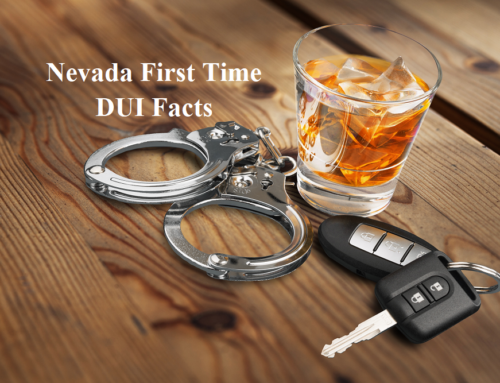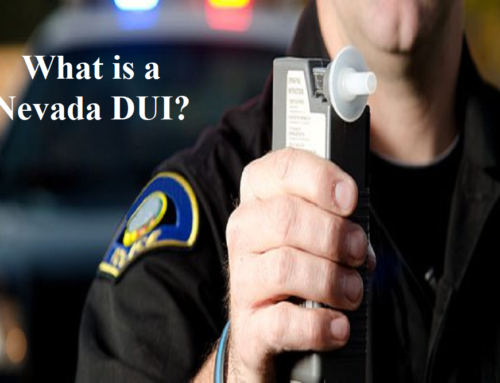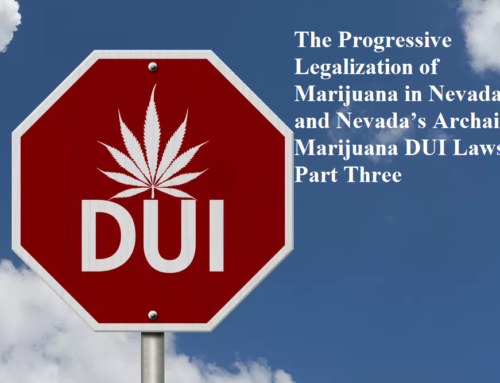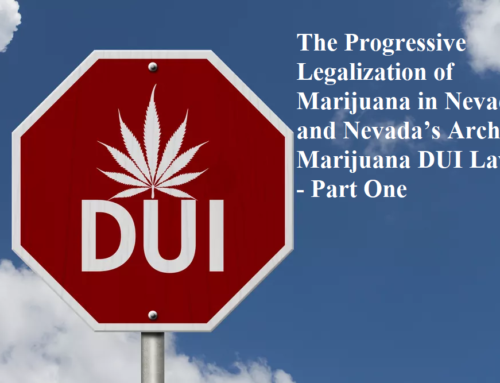***This is part two (2) of a three part article. Part one (1) can be found here. Part three (3) can be found here.***
Nevada’s Current Marijuana DUI Laws.
On July 1, 2017, the Nevada legislature did amend Nevada’s marijuana DUI laws. However, rather than amending the law to make it more rational (i.e., amend it to punish drivers that are impaired by marijuana), the amendments did not increase the previous per se levels at all. Specifically, the legislature amended the marijuana DUI laws to remove urine as a potential matrix for analysis and to clarify the definition of “marijuana metabolite.” Thankfully, the legislature did amend the definition of “marijuana metabolite” to mean Hydroxy-THC only (not Carboxy-THC). The new marijuana DUI laws provides as follows:
It is unlawful for any person to drive or be in actual physical control of a vehicle on a highway or on premises to which the public has access with an amount of any of the following prohibited substances in his or her blood that is equal to or greater than:
| Prohibited substance Blood Nanograms per milliliter | Blood Nanograms per milliliter | |
| (a) | Marijuana (delta-9-tetrahydrocannabinol) 2 | 2 | |
| (b) | Marijuana metabolite (11-OH-tetrahydrocannabinol) 5 | 5 |
At the beginning of this article, I stated that you should be disappointed with the current marijuana DUI laws. The reason you should be disappointed is simple; given the substantial variables that impact marijuana-consumption and impairment, there is simply no correlation between an individual’s THC levels and impairment. Marijuana is NOT like alcohol when it comes to impairment (which is another argument entirely). As indicated earlier, even a study sponsored by NHTSA came to this conclusion. Why should this study matter to you? NHTSA is the federally funded organization that is responsible for the standardization of DUI field sobriety tests. They are the organization that sets policy and protocol for the certification of law enforcement officers as “DREs” (drug recognition experts or evaluators in marijuana-impaired cases). They are the organization that sets the curriculum for DUI recognition, investigation and arrest for law enforcement officers. In other words, they are on MADD’s side, not the criminal defense bar. Obviously, the purpose of this article is not to advocate DUI or even relaxed marijuana DUI laws. The tragedies of DUI in this country are legion. I am a Las Vegas native and have a 14-year-old son. The last thing I would advocate for Nevadans is a law that permits impaired drivers to endanger Nevada citizens.
However, there is a flip-side to that coin; driving under the influence laws are supposed to prohibit and punish driving under the influence; not driving with some meaningless level of a legally consumable substance (or metabolite of a legally consumable substance) in your system. Imagine if your son or daughter was involved in a car accident an hour after he/she “took a drag” from a joint. They would face mandatory years in prison if someone died or was even substantially harmed predicated only upon some meaningless level of substance in their blood.
If you are losing interest in this marijuana DUI laws article because “neither you nor you loved ones ‘smoke pot,’” consider the following study. In 2015, the Journal of Analytical Toxicology published an article (“Cone Article”) concerning an experiment on the effects of second-hand smoke of marijuana. The scientists who conducted the experiment concluded:
that environmental exposure to cannabis smoke should be avoided by nonsmokers and potentially has implications for those who undergo drug testing and those engaged in safety-sensitive activities (e.g., driving). Extreme exposure of nonsmokers could lead to positive drug tests and drug-induced behavioral changes not unlike those produced by active cannabis smoking. In fact, the scientists concluded that ‘[p]ositive tests for THC in . . . blood were obtained for nonsmokers up to 3 h[ours] following exposure.’[1]
The results of the foregoing study revealed that 16 out of the 18 non-smoking participants that were exposed to second-hand marijuana smoke tested positive for THC from 15 minutes to 3 hours after being exposed. Even more alarming, 4 of the 18 non-smoking participants tested positive for THC above Nevada’s current per se levels for THC (2 ng/ml or above); one of which tested positive at 5.6 ng/ml just 15 minutes after exposure.
Although the authors of the study characterized the second-hand exposure as “extreme,” the study reveals that non-smokers were simply seated next to smokers for hour-long sessions. Testing positive for THC after just 15 minutes of “exposure” from being seated next to someone sounds more like a Tuesday-night poker game than “extreme exposure.” The scientists concluded:
[the] combined body of data suggest that environmental exposure to cannabis smoke should be avoided by nonsmokers and potentially has implications for those who undergo drug testing and those engaged in safety-sensitive activities (e.g., driving).[2]
There is No Correlation Between THC Levels and Impairment
In July 2017, NHTSA prepared a Report to Congress concerning Marijuana-Impaired Driving (hereinafter “the Report”).[3] The Report was prepared in accordance with Section 4008 of the Fixing America’s Surface Transportation Act and its purpose was to summarize “what is known about marijuana use and driving.” Id., at Abstract. The Report highlights “[t]he poor correlation of THC concentrations in the blood with impairment . . . along with the implication that setting per se levels is not meaningful.” Id.
The Report is clear that the human body metabolizes alcohol and marijuana much differently.
[A]lcohol is a relatively simple drug whose absorption, distribution and elimination from the body along with the behavioral and cognitive effects are fairly well documented.
In comparison, the absorption, distribution and elimination from the body of marijuana (and many other drugs), along with the behavioral and cognitive effects is very different from the case with alcohol.
While ethyl alcohol is readily soluble in water, and hence blood, THC is fat soluble. This means that once ingested, THC is stored in fatty tissues in the body and can be released back into the blood sometimes long after ingestion. Some studies have detected THC in the blood at 30 days post ingestion. Thus, while THC can be detected in the blood long after ingestion, the acute psychoactive effects of marijuana ingestion last for mere hours, not days or weeks. Also, unlike alcohol, which is metabolized at a steady rate, the metabolism of THC occurs in a different fashion such that THC blood levels decline exponentially. Id., at 4-5 (emphasis added) (internal citations omitted).
The foregoing differences in the way the substances are metabolized results in the detectable levels of the substances in blood “peaking” and dropping at much different times.
THC levels drop rapidly after cessation of smoking. In contrast to alcohol, which is metabolized at a relatively steady rate, THC is metabolized at an exponentially declining rate where the THC blood level first drops rapidly, followed by a slower decline as lower THC levels are reached. [W]ithin 30 minutes [of smoking] the THC level has dropped to 80 – 90 percent of the peak level. After a few hours only low or no THC can be detected in the blood. Very low THC levels may persist in the blood from a single administration for more than six hours.
While peak THC levels occur right after smoking ends, when alcohol is ingested by drinking, a peak BAC level in the blood or breath does not occur until sometime after the last drink is consumed. As mentioned above, alcohol primarily is absorbed into the blood (and hence into the lungs) through the gastrointestinal tract. Depending on a variety of factors it can take 20 minutes or more before alcohol is detectable in the blood or breath. The peak BAC level is dependent on the rate of intake and the rate of elimination. For the average person BAC is eliminated at a steady rate of approximately .015 BAC per hour. See Report, supra at 5.
Significantly, while it “has been well established through a large number of carefully controlled studies” that “the effects of alcohol consumption on behavior, judgement, cognition and emotions all correlate fairly well with the rise and fall of alcohol concentration in the body,” the same is not true for marijuana concentrations. Id., at 6.
The higher the alcohol concentration the greater the impairment that was observed. As alcohol concentration rose so did the degree of impairment; as alcohol concentration declined so did the degree of impairment. Id.
While alcohol concentration (BAC or BrAC) is an accurate measurement of alcohol impairment of driving, the presence of THC in the driver’s body has not been shown to be a reliable measure of marijuana impairment of driving. Id. at 13-14.
With marijuana, conversely, in “studies [that] have examined the relationship between THC blood levels and degree of impairment, . . . the consistent finding is that the level of THC in the blood and the degree of impairment do not appear to be closely related.” Id., at 7. Unlike with alcohol, “[p]eak impairment does not occur when THC concentration in the blood is at or near peak levels.” Id.
Peak THC level can occur when low impairment is measured, and high impairment can be measured when THC level is low. Thus, in contrast to the situation with alcohol, someone can show little or no impairment at a THC level at which someone else may show a greater degree of impairment. Id. (emphasis added).
The foregoing lack of correlation between impairment and THC levels in the blood is particularly important for Nevada motorists given Nevada’s extremely low per se level for marijuana (2 ng/mL). In fact, the NHTSA Report expressly commented that “[l]ow THC levels of a few nanograms per milliliter (ng/ml) in blood can result from . . . chronic use where no recent ingestion has occurred and no impairment is present.” Id. (emphasis added).
THC level in blood does not appear to be an accurate and reliable predictor of impairment from THC. Also, when low levels of THC are found in the blood, the presence of THC is not a reliable indicator of recent marijuana use.
Despite the foregoing lack of accuracy and reliability, Nevada marijuana DUI laws currently criminalizes driving or having actual physical control of a vehicle with only 2 ng/mL of marijuana in the blood. NRS § 484C.110(4)(a).
The NHTSA Report set forth the following alarming conclusions:
[R]esearch . . . does not show a relationship between THC levels and impairment. See Report, supra at 11.
[T]here are currently no evidence-based methods to detect marijuana-impaired driving. Id. at 13.
The psychoactive ingredient in marijuana, delta-9-tetrahydrocannabinal (THC), does not correlate well with impairment. Id. at 13.
Traditionally, measurement of marijuana use by drivers has involved testing biological specimens for the presence of THC (typically blood samples, though urine and other substance have been used). Such tests not only indicate whether THC was present in the sample tested, they also quantify the concentration or amount of THC detected. These toxicological tests confirm presence of THC but they do not indicate driver impairment or necessarily indicate recent marijuana use (when the THC levels are low). Id. at 14 (emphasis added).
While the presence of THC in a driver (blood, oral fluid, etc.) does not establish impairment, it also does not distinguish been active use of marijuana and environmental exposure or contamination. Some studies have shown that people exposed to second-hand marijuana smoke can test positive for THC. Id. at 15.
Low THC levels of a few nanograms per milliliter (ng/ml) in blood can result from relatively recent use (e.g., smoking within 1 – 3 hours) when some slight or even moderate impairment is likely to be present, or it can result from chronic use where no recent ingestion has occurred and no impairment is present. Id., at 7 (emphasis added).
[T]he poor correlation of THC level in the blood or oral fluid with impairment precludes using THC blood or oral fluid levels as an indicator of driver impairment. The use of BAC or BrAC as an indicator of driving impairment has assisted law enforcement and prosecutors in being able to show that an alcohol-impaired driver has a BAC that has been demonstrated to increase crash risk. The use of THC level cannot serve this same role for marijuana-impaired driving. Id. at 27 (emphasis added).
Toxicologists are not able to provide expert testimony that a specific amount of THC present in a suspect’s blood (or other specimen) is definitively associated with being impaired by marijuana and render the driver unable to drive safely. Id. at 28.
The lack of toxicological evidence simply means that the officer has to offer other evidence that the driver was under the influence of marijuana and too impaired to drive safely. Id.
Poor correlation between THC concentration and performance was found, which again indicates that blood THC level is not a reliable indicator of impairment. Id. at 29.
The conclusion of the study was that “there is no evidence from the data collected . . . that any objective threshold exists that establish impairment base on THC concentrations in suspects placed under arrest for impaired driving. Id. at 29.
Similarly, in response to many State’s legalization of the recreational use of marijuana, the AAA Foundation for Traffic Safety (“AAA”) performed a study to determine whether, like alcohol, there should be a threshold or per se level for marijuana in marijuana DUI laws. The findings of the study were set forth in a report issued in May of 2016.[4] The AAA “is a not-for-profit, publicly supported charitable research and education organization dedicated to saving lives by preventing traffic crashes and reducing injuries when crashes occur.” See Evaluation, supra. The purpose of the study was defined as follows:
One of the major concerns shared by both opponents and proponents of greater access to cannabis is its impact on driver performance and relationship to adverse
effects on traffic safety. – These concerns have led to a strong desire among lawmakers and traffic safety advocates to consider laws that criminalize cannabis-involved driving including laws that set a quantitative threshold for concentration of delta-9-tetrahydrocannabinol (THC), the primary active component of cannabis, in a person’s blood. – What that threshold should be is a subject of much debate, and this study was undertaken to determine whether data from the Drug Recognition Expert (DRE) program consisting of physiological indicators of drug use, and performance in roadside cognitive and psychomotor tests, supported any particular quantitative threshold for a per se law for THC. Id., at 1.
Thus, the purpose of the study was to determine whether any scientific evidence and/or data supported a correlation between a specific level of THC in the blood and impairment. The AAA focused its study on the validity and reliability of a 5 ng/mL per se level “as a means of assessing the validity of a numerical THC threshold value above which impairment is more likely, and which thus might be a candidate for an impairment based per se law.” Id., at 16. Nevada’s current per se level is 2 ng/mL.
The rationale for this was to select a threshold that has been adopted by three states (Washington, Montana and Colorado), and proposed in several others, and is the concentration cited in a frequently cited meta-analysis of published experimental work as a putative threshold for impairment based per se thresholds. Id.
In performing its evaluation, the AAA considered data from NHTSA’s Drug Recognition Expert (“DRE”) program that consisted of “physiological indicators of drug use and performance in roadside cognitive and psychomotor tests.” Id. at 1. The evaluation included data from:
602 drivers arrested for impaired driving in which only THC was present, along with a sample of 349 drug-free controls, in which full records of the subjects’ performance in the DRE exam were available; and 4,799 drivers arrested for impaired driving who tested positive for one or more cannabinoids (THC, hydroxy-THC, and carboxy-THC), and for which demographic information and comprehensive toxicology testing results were available. Id.
After considering the foregoing substantial data, the AAA concluded that “[t]he evidence was very clear that 5 ng/mL was not a good discriminator of impairment.” Id. at 25. Once again, Nevada’s per se marijuana level for DUI, both before marijuana was legalized and after, was and remains 2 ng/mL. The AAA therefore concluded that a level of THC that is 250% higher than Nevada’s per se level is not indicative of impairment.
Moreover, the AAA further included that “lower per se threshold” levels “starts to encompass individual heavy users of cannabis with residual THC concentrations long after use, or passive inhalation of THC from side-stream smoke under some extreme circumstances.” Id. at 26. Similar to the Cone and Bigelow study discussed supra, the AAA Evaluation cautioned that low per se levels, discussing 5 ng/mL as a “lower level” when Nevada’s per se level is 2 ng/mL, would likely lead to convictions of legal users that are not impaired at all as well as convictions of persons that did not use but were simply exposed to second-hand smoke. Id. The AAA ended its Evaluation with the following conclusion:
our study provides valuable information about the THC concentrations among cannabis-positive individuals who have been arrested for impaired driving. The data do not support science-based per se limits for THC. Id. at 28 (emphasis added).
[1] Cone, E.J., Bigelow, G.E., Herrmann, E.S., Mitchell, J.M., LoDico, C., Flegel, R., and Vandrey, R., Nonsmoker Exposure to Secondhand Smoke. III. Oral Fluid and Blood Drug Concentrations and Corresponding Subjective Effects. Journal of Analytical Toxicology 2015:39:497-509 at p. 12.
[2] Id.
[3] Compton, R. (2017, July). Marijuana-Impaired Driving – A Report to Congress. (DOT HS 812 440). Washington, DC: National Highway Traffic Safety Administration.
[4] Logan, B.K., Kacinko, S.L., Beirness, D.J. (2016), An Evaluation of Data from Drivers Arrested for Driving Under the Influence in Relation to Per se Limits for Cannabis (2016), American Automobile Association Foundation for Traffic Safety, May 2016 (hereinafter “Evaluation”).
***This article has been broken up into three (3) parts. This concludes the end of part two (2).***

